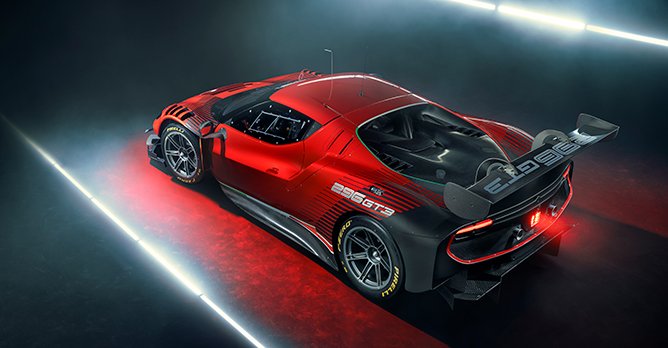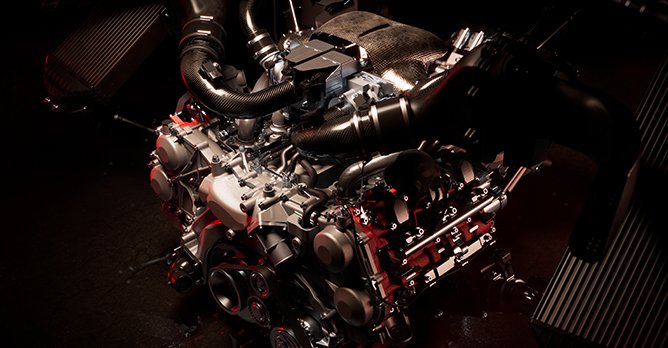New Ferrari 296 GT3 to take over racing mantle from previous 488 GT3
01 Aug 2022|1,961 views
After decades of using V8 powered cars in the GT3 racing series, Ferrari has launched a new 296 GT3 race car, marking its return to the use of V6 power. The 296 GT3 utilises the same turbo configuration and a 120 degree vee configuration as the road-going Ferrari 296 GTB, allowing more compactness, a lower centre of gravity and reduced mass. The engine however is further forward and lower down than in the road version, which helps improve rigidity.
The gearbox is a bespoke job, with a single disc clutch unit with six gears, arranged transversely for better aerodynamics and weight distribution. Clutch actuation is now electronic and can be controlled from the steering wheel, rather than mechanical via the foot pedal while gear change is electrically controlled.
Moving on to the exterior, Ferrari's engineers have reduced ride height sensitivities with the goal of improving handing and driveability. This engineering effort has yielded a gain of 20% in downforce over the previous generation 488 GT3. Improved downforce translates to an increase in grip and handling on track.
When it comes to the design of the cockpit, intuitiveness, visibility and accessibility were key factors in development while not compromising on safety and comfort. After receiving feedback from the previous generation GT3 racer from customers and race car drivers, Ferrari has reworked the cockpit from the ground up.
For example, main functions of the car are now placed within easier reach for the driver. Controls and functions have moved to the steering wheel for easier and faster access, while the position of the Sabelt racing specification seatbelts have been optimised to enhance visibility in day and night. Adjustable pedals and steering is also introduced to fit drivers of different statures.
In order to replicate the previous success of the 488 GT3 race car, Ferrari has placed great emphasis on the chassis and vehicle dynamics of the 296 GT3. The chassis is now made of aluminium and can exploit the full grip potential without compromising their integrity, benefitting performance and reliability.
The chassis has also achieved extreme lightness, allowing ballast to be placed around the car more effectively. The wheelbase is also longer than the road going model with double wishbone arms in the front and rear suspension to offer maximum grip at high speeds and reduced stress on the tyres.
The braking system now features newly designed calipers and discs (400mm at the front). Ferrari's partnership with Rotiform has produced a new forged wheel homologated specifically for the 296 GT3.
The gearbox is a bespoke job, with a single disc clutch unit with six gears, arranged transversely for better aerodynamics and weight distribution. Clutch actuation is now electronic and can be controlled from the steering wheel, rather than mechanical via the foot pedal while gear change is electrically controlled.
Moving on to the exterior, Ferrari's engineers have reduced ride height sensitivities with the goal of improving handing and driveability. This engineering effort has yielded a gain of 20% in downforce over the previous generation 488 GT3. Improved downforce translates to an increase in grip and handling on track.
When it comes to the design of the cockpit, intuitiveness, visibility and accessibility were key factors in development while not compromising on safety and comfort. After receiving feedback from the previous generation GT3 racer from customers and race car drivers, Ferrari has reworked the cockpit from the ground up.
For example, main functions of the car are now placed within easier reach for the driver. Controls and functions have moved to the steering wheel for easier and faster access, while the position of the Sabelt racing specification seatbelts have been optimised to enhance visibility in day and night. Adjustable pedals and steering is also introduced to fit drivers of different statures.
In order to replicate the previous success of the 488 GT3 race car, Ferrari has placed great emphasis on the chassis and vehicle dynamics of the 296 GT3. The chassis is now made of aluminium and can exploit the full grip potential without compromising their integrity, benefitting performance and reliability.
The chassis has also achieved extreme lightness, allowing ballast to be placed around the car more effectively. The wheelbase is also longer than the road going model with double wishbone arms in the front and rear suspension to offer maximum grip at high speeds and reduced stress on the tyres.
The braking system now features newly designed calipers and discs (400mm at the front). Ferrari's partnership with Rotiform has produced a new forged wheel homologated specifically for the 296 GT3.
After decades of using V8 powered cars in the GT3 racing series, Ferrari has launched a new 296 GT3 race car, marking its return to the use of V6 power. The 296 GT3 utilises the same turbo configuration and a 120 degree vee configuration as the road-going Ferrari 296 GTB, allowing more compactness, a lower centre of gravity and reduced mass. The engine however is further forward and lower down than in the road version, which helps improve rigidity.
The gearbox is a bespoke job, with a single disc clutch unit with six gears, arranged transversely for better aerodynamics and weight distribution. Clutch actuation is now electronic and can be controlled from the steering wheel, rather than mechanical via the foot pedal while gear change is electrically controlled.
Moving on to the exterior, Ferrari's engineers have reduced ride height sensitivities with the goal of improving handing and driveability. This engineering effort has yielded a gain of 20% in downforce over the previous generation 488 GT3. Improved downforce translates to an increase in grip and handling on track.
When it comes to the design of the cockpit, intuitiveness, visibility and accessibility were key factors in development while not compromising on safety and comfort. After receiving feedback from the previous generation GT3 racer from customers and race car drivers, Ferrari has reworked the cockpit from the ground up.
For example, main functions of the car are now placed within easier reach for the driver. Controls and functions have moved to the steering wheel for easier and faster access, while the position of the Sabelt racing specification seatbelts have been optimised to enhance visibility in day and night. Adjustable pedals and steering is also introduced to fit drivers of different statures.
In order to replicate the previous success of the 488 GT3 race car, Ferrari has placed great emphasis on the chassis and vehicle dynamics of the 296 GT3. The chassis is now made of aluminium and can exploit the full grip potential without compromising their integrity, benefitting performance and reliability.
The chassis has also achieved extreme lightness, allowing ballast to be placed around the car more effectively. The wheelbase is also longer than the road going model with double wishbone arms in the front and rear suspension to offer maximum grip at high speeds and reduced stress on the tyres.
The braking system now features newly designed calipers and discs (400mm at the front). Ferrari's partnership with Rotiform has produced a new forged wheel homologated specifically for the 296 GT3.
The gearbox is a bespoke job, with a single disc clutch unit with six gears, arranged transversely for better aerodynamics and weight distribution. Clutch actuation is now electronic and can be controlled from the steering wheel, rather than mechanical via the foot pedal while gear change is electrically controlled.
Moving on to the exterior, Ferrari's engineers have reduced ride height sensitivities with the goal of improving handing and driveability. This engineering effort has yielded a gain of 20% in downforce over the previous generation 488 GT3. Improved downforce translates to an increase in grip and handling on track.
When it comes to the design of the cockpit, intuitiveness, visibility and accessibility were key factors in development while not compromising on safety and comfort. After receiving feedback from the previous generation GT3 racer from customers and race car drivers, Ferrari has reworked the cockpit from the ground up.
For example, main functions of the car are now placed within easier reach for the driver. Controls and functions have moved to the steering wheel for easier and faster access, while the position of the Sabelt racing specification seatbelts have been optimised to enhance visibility in day and night. Adjustable pedals and steering is also introduced to fit drivers of different statures.
In order to replicate the previous success of the 488 GT3 race car, Ferrari has placed great emphasis on the chassis and vehicle dynamics of the 296 GT3. The chassis is now made of aluminium and can exploit the full grip potential without compromising their integrity, benefitting performance and reliability.
The chassis has also achieved extreme lightness, allowing ballast to be placed around the car more effectively. The wheelbase is also longer than the road going model with double wishbone arms in the front and rear suspension to offer maximum grip at high speeds and reduced stress on the tyres.
The braking system now features newly designed calipers and discs (400mm at the front). Ferrari's partnership with Rotiform has produced a new forged wheel homologated specifically for the 296 GT3.
Latest COE Prices
December 2025 | 1st BIDDING
NEXT TENDER: 17 Dec 2025
CAT A$105,413
CAT B$123,900
CAT C$76,501
CAT E$123,000
View Full Results Thank You For Your Subscription.




























